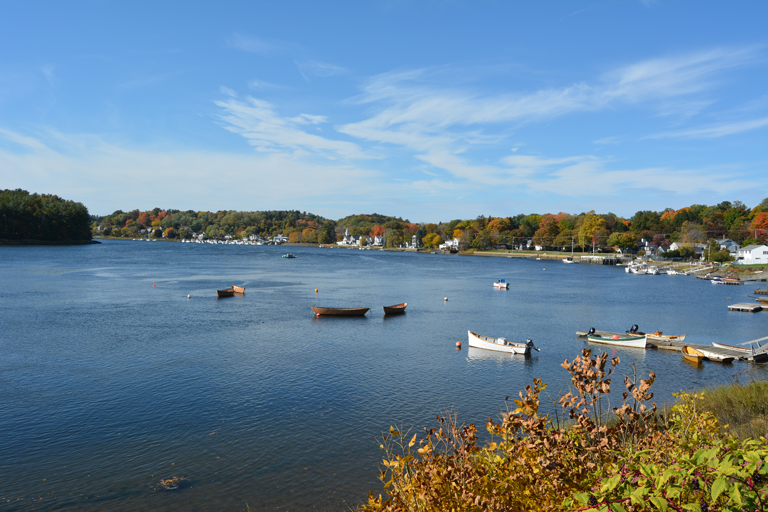call us at 978-388-5111
Located at the confluence of the Merrimack and Powow Rivers, The Marina at Amesbury Point is steeped in nautical history. Unlike many of the surrounding settlements of the 1700s, Amesbury was less agricultural and more reliant on a maritime economy. Shipbuilding, shipping, fishing, and ferrying employed the majority of Amesbury’s population.
Thanks in large part to the historical research done by Amesbury resident Margaret Rice, we have a colorful narrative of Amesbury’s ties to the Merrimack River and its contribution to local and world economies.
Before the English settlers arrived, the lower Merrimack River was occupied by tribes of Algonquin and Pennacook Native Americans. It is estimated that as many as 12,000 Penacook inhabited the area. The river provided easy transportation, and there was an abundance of fish and game to sustain the population. Many of our current roads were originally Pennacook hunting trails; Ferry Rd in Newburyport, Seabrook Road in Salisbury, and Elm Street in Amesbury to name a few. In the late 1970s, the Early Site Research Society conducted excavations at an ancient earthen burial mound located at Morrill Point near the mouth of the Merrimack River in Salisbury, MA. Teams found several burials with skeletons that were near perfectly preserved. Evidence indicated long term use of the burial site by generations of Native American Indians. The earliest set of remains dated back over 6000 years. In addition to Morrill Point, Native American earthen ceremonial mounds can also be found in Maudsley State Park, located directly across the river from The Marina at Amesbury Point. In the early 17th century, fishermen visiting Salisbury, prior to colonization, brought European diseases that hit the local Pennacook tribe hard. Between 1649 and 1650, ninety percent of the Pennacook population had been desimated.
It was during this same time period that the English settlers arrived in increasing numbers. Settlers vied with the local native American tribes for use of the Merrimack River. Forests were cleared for farming and logs were rafted downstream for the growing need of construction material. The abundance of quality oak and easy river transport spawned a robust shipping and ship building economy. By 1675, what remained of the Pennacook tribe were forced to abandon the area and migrate to New Hampshire, Maine and Canada, and absorbed into the Abenaqui tribe.
The first business in this area was an Amesbury sawmill, powered by the 90 foot drop of the Powow River to the Merrimack River. The export route for milled material ran down the Powow to a ferry, situated where The Marina at Amesbury Point is today. Material was then ferried across the Merrimack to what is known today as Old Ferry Road and from there, transported along High Street in Newburyport to the docks on the Parker River in Newbury. The saw mill’s primary export was oak staves sent to the West Indies to make rum barrels. A grist mill was subsequently added to the mill complex. This was the first settlement of what was to become Amesbury.
By the end of the 17th century, this area became known as the “Ferry District” and was the gateway to Amesbury’s earliest settlement and the center of its commerce and government. At this time, there were only two ferry operations, one at the Powow and Merrimack junction called “The Ferry” and the other three miles downstream at Carr’s Island.
By 1710, a shipping and shipbuilding boom had begun. Sugar and dried fish were the main products being shipped. Dried fish was an inexpensive source of protein for West India slaves working the sugar plantations. The return trip carried West India sugar.
By the mid 18th century, there were two dozen shipyards located on Salisbury Point, now known as Point Shore. Two thousand ship carpenters, caulkers, and other skilled ship workers were employed in the shipyards. Schooners, sloops, brigs, frigates, privateers, and some full-rigged ships were built here. It is estimated that well over 600 vessels in the 50 to 800 ton size were made and launched at this location. It may interest you to know that “The Essex” was built in Amesbury. Built as a merchant vessel in 1799, the 87 foot Essex was converted to a whaling ship and sailed out of Nantucket. Twenty years after its launch, the Essex was fatally struck by a sperm whale estimated to be 85 feet in length. It is the account of this event that inspired Herman Melville to write Moby Dick.
Today, Lowell Boat Shop remains as a testament to Amesbury’s shipbuilding past and is recognized as the oldest continually operated boat builder in the country, having begun operation in 1793. Lowell Boat Shop is the birthplace of the classic New England dory; a vessel that has stood the test of time and is still being produced today.
In 1792, “The Ferry” ceased operation when the Essex-Merrimac bridge was constructed.
Since closing as a ferry operation, the site has been home to ship builders, wharf builders, and marina operations.
The Marina at Amesbury Point is proud to continue the unbroken chain of maritime activity at this location on the Merrimack River. Now, as when the original English settlers arrived here, members of The Marina at Amesbury Point are treated to the natural beauty of this site. The river is still home to a healthy sturgeon population, eagles, and osprey still nest here, waterfowl thrive and harbor seals and bottlenose dolphins can be spotted from our docks.
Join us and see what you’ve been missing.
“CLICK HERE TO PREVIEW “PLANS FOR THE FUTURE”

